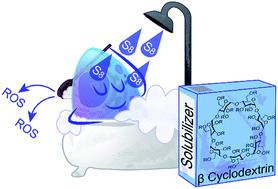当前位置:
X-MOL 学术
›
Chem. Sci.
›
论文详情
Our official English website, www.x-mol.net, welcomes your feedback! (Note: you will need to create a separate account there.)
Modified cyclodextrins solubilize elemental sulfur in water and enable biological sulfane sulfur delivery
Chemical Science ( IF 8.4 ) Pub Date : 2020-10-05 , DOI: 10.1039/d0sc04137h Sarah G. Bolton 1, 2, 3, 4, 5 , Michael D. Pluth 1, 2, 3, 4, 5
Chemical Science ( IF 8.4 ) Pub Date : 2020-10-05 , DOI: 10.1039/d0sc04137h Sarah G. Bolton 1, 2, 3, 4, 5 , Michael D. Pluth 1, 2, 3, 4, 5
Affiliation

|
An important form of biological sulfur is sulfane sulfur, or S0, which is found in polysulfide and persulfide compounds as well as in elemental sulfur. Sulfane sulfur, often in the form of S8, functions as a key energy source in the metabolic processes of thermophilic Archaean organisms found in sulfur-rich environments and can be metabolized both aerobically and anaerobically by different archaeons. Despite this importance, S8 has a low solubility in water (∼19 nM), raising questions of how it can be made chemically accessible in complex environments. Motivated by prior crystallographic data showing S8 binding to hydrophobic motifs in filamentous glycoproteins from the sulfur reducing Staphylothermus marinus anaerobe, we demonstrate that simple macrocyclic hydrophobic motifs, such as 2-hydroxypropyl β-cyclodextrin (2HPβ), are sufficient to solubilize S8 at concentrations up to 2.0 ± 0.2 mM in aqueous solution. We demonstrate that the solubilized S8 can be reduced with the common reductant tris(2-carboxyethyl)phosphine (TCEP) and reacts with thiols to generate H2S. The thiol-mediated conversion of 2HPβ/S8 to H2S ranges from 80% to quantitative efficiency for Cys and glutathione (GSH). Moreover, we demonstrate that 2HPβ can catalyze the Cys-mediated reduction of S8 to H2S in water. Adding to the biological relevance of the developed systems, we demonstrate that treatment of Raw 264.7 macrophage cells with the 2HPβ/S8 complex prior to LPS stimulation decreases NO2− levels, which is consistent with known activities of bioavailable H2S and sulfane sulfur. Taken together, these investigations provide a new strategy for delivering H2S and sulfane sulfur in complex systems and more importantly provide new insights into the chemical accessibility and storage of S0 and S8 in biological environments.
中文翻译:

改性环糊精可溶解水中的元素硫并实现生物硫磺的输送
生物硫的一种重要形式是硫丹,即S 0,它存在于多硫化物和过硫化物以及元素硫中。硫磺(通常为S 8形式)是在富含硫的环境中发现的嗜热古生生物代谢过程中的关键能源,可以通过不同的古生菌进行需氧和厌氧代谢。尽管具有这种重要性,S 8在水中的溶解度很低(〜19 nM),这引发了人们对如何使其在复杂环境中化学可及性的疑问。由先前的晶体学数据表明,S 8与硫减少的葡萄球菌的丝状糖蛋白中的疏水基序结合厌氧菌,我们证明了简单的大环疏水基序,例如2-羟丙基β-环糊精(2HPβ),足以在水溶液中以高达2.0±0.2 mM的浓度溶解S 8。我们表明,溶解的小号8可以与共同还原剂可以减少三(2-羧乙基)膦(TCEP)并反应与硫醇以产生H 2 S的2HPβ的硫醇介导的转化/ S 8至H 2期从范围半胱氨酸和谷胱甘肽(GSH)定量效率的80%。此外,我们证明了2HPβ可以催化Cys介导的S 8还原为H 2S在水中。添加到开发的系统的生物相关性,我们表明,治疗原始的264.7巨噬细胞用2HPβ/ S 8复杂之前LPS刺激减少NO 2 -的水平,这是与生物可利用的H的已知活性一致2 S和硫烷硫。综上所述,这些研究提供了在复杂系统中输送H 2 S和硫烷硫的新策略,更重要的是,它为生物环境中S 0和S 8的化学可及性和储存提供了新的见解。
更新日期:2020-10-12
中文翻译:

改性环糊精可溶解水中的元素硫并实现生物硫磺的输送
生物硫的一种重要形式是硫丹,即S 0,它存在于多硫化物和过硫化物以及元素硫中。硫磺(通常为S 8形式)是在富含硫的环境中发现的嗜热古生生物代谢过程中的关键能源,可以通过不同的古生菌进行需氧和厌氧代谢。尽管具有这种重要性,S 8在水中的溶解度很低(〜19 nM),这引发了人们对如何使其在复杂环境中化学可及性的疑问。由先前的晶体学数据表明,S 8与硫减少的葡萄球菌的丝状糖蛋白中的疏水基序结合厌氧菌,我们证明了简单的大环疏水基序,例如2-羟丙基β-环糊精(2HPβ),足以在水溶液中以高达2.0±0.2 mM的浓度溶解S 8。我们表明,溶解的小号8可以与共同还原剂可以减少三(2-羧乙基)膦(TCEP)并反应与硫醇以产生H 2 S的2HPβ的硫醇介导的转化/ S 8至H 2期从范围半胱氨酸和谷胱甘肽(GSH)定量效率的80%。此外,我们证明了2HPβ可以催化Cys介导的S 8还原为H 2S在水中。添加到开发的系统的生物相关性,我们表明,治疗原始的264.7巨噬细胞用2HPβ/ S 8复杂之前LPS刺激减少NO 2 -的水平,这是与生物可利用的H的已知活性一致2 S和硫烷硫。综上所述,这些研究提供了在复杂系统中输送H 2 S和硫烷硫的新策略,更重要的是,它为生物环境中S 0和S 8的化学可及性和储存提供了新的见解。



























 京公网安备 11010802027423号
京公网安备 11010802027423号